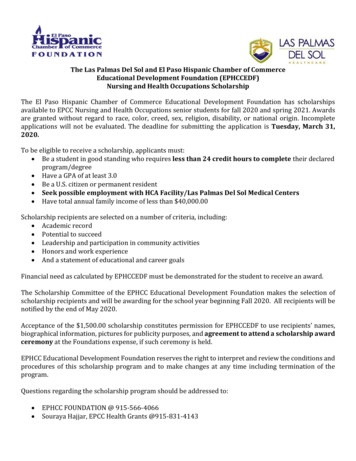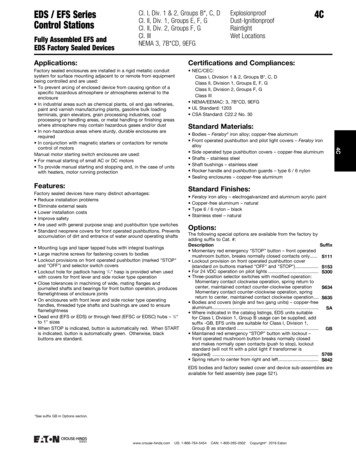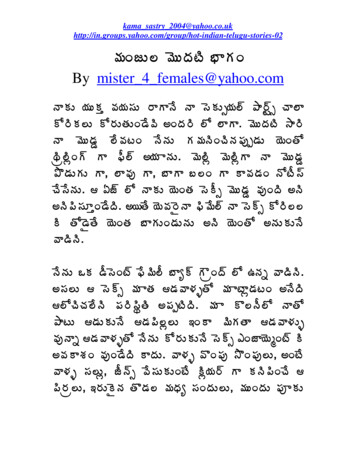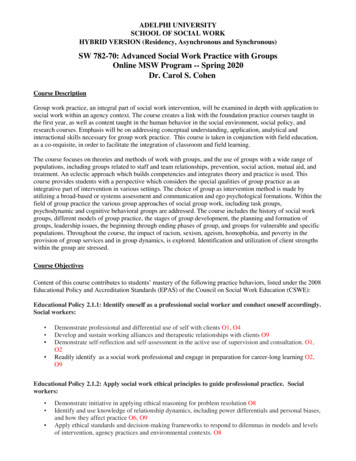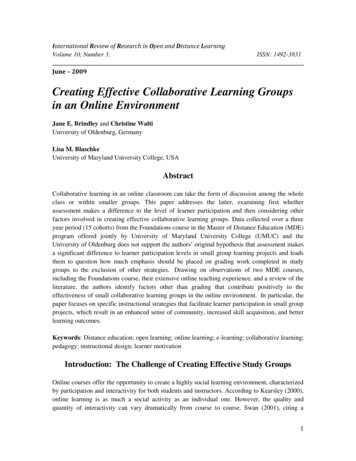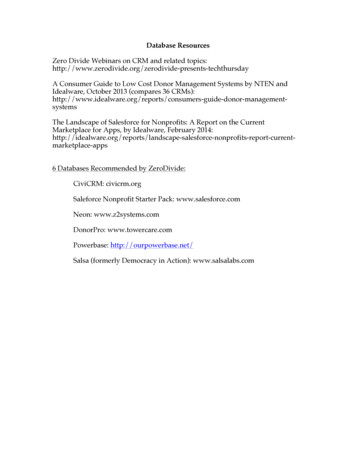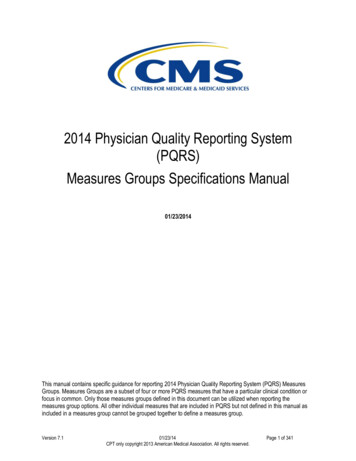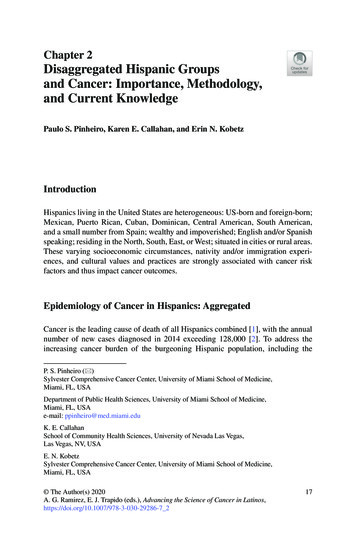
Transcription
Chapter 2Disaggregated Hispanic Groupsand Cancer: Importance, Methodology,and Current KnowledgePaulo S. Pinheiro, Karen E. Callahan, and Erin N. Kobetz IntroductionHispanics living in the United States are heterogeneous: US-born and foreign-born;Mexican, Puerto Rican, Cuban, Dominican, Central American, South American,and a small number from Spain; wealthy and impoverished; English and/or Spanishspeaking; residing in the North, South, East, or West; situated in cities or rural areas.These varying socioeconomic circumstances, nativity and/or immigration experiences, and cultural values and practices are strongly associated with cancer riskfactors and thus impact cancer outcomes. Epidemiology of Cancer in Hispanics: AggregatedCancer is the leading cause of death of all Hispanics combined [1], with the annualnumber of new cases diagnosed in 2014 exceeding 128,000 [2]. To address theincreasing cancer burden of the burgeoning Hispanic population, including theP. S. Pinheiro (*)Sylvester Comprehensive Cancer Center, University of Miami School of Medicine,Miami, FL, USADepartment of Public Health Sciences, University of Miami School of Medicine,Miami, FL, USAe-mail: ppinheiro@med.miami.eduK. E. CallahanSchool of Community Health Sciences, University of Nevada Las Vegas,Las Vegas, NV, USAE. N. KobetzSylvester Comprehensive Cancer Center, University of Miami School of Medicine,Miami, FL, USA The Author(s) 2020A. G. Ramirez, E. J. Trapido (eds.), Advancing the Science of Cancer in Latinos,https://doi.org/10.1007/978-3-030-29286-7 217
18P. S. Pinheiro et al.development of cancer prevention and control strategies, all stakeholders, from clinicians to researchers to policymakers, must have timely and accurate population- based cancer indicators, namely incidence, survival, and mortality. Incidencepatterns are routinely reported by the North American Association of Central CancerRegistries (NAACCR) in their Cancer in North American (CiNA) Annual Reports[3] and the Annual Reports on Cancer, which group data from the Surveillance,Epidemiology, and End Results Program (SEER) and the National Program forCancer Registries (NPCR) [4]. In addition, SEER provides data available for survival estimates of Hispanics [5], and mortality data are provided by the NationalCenter for Health Statistics within the Centers for Disease Control and Prevention(CDC) [6].However, accurate indicators for Hispanics are affected by specific problems.Hispanics are known to be undercounted at the cancer registry level [7, 8], largelydue to incompleteness of the ethnicity variable. NAACCR protocols for the calculation of incidence rates reduce this undercount by using the NAACCR HispanicIdentification Algorithm (NHIA) which relies partly on Hispanic surname [9].Mortality data also suffer from some degree of undercount, potentially up to 5%[10]; however, routine use of similar algorithms does not take place. Nonetheless,Hispanic incidence and mortality estimates are generally consistent with each otherand show that US Hispanics in aggregate have lower cancer incidence and mortalityrates (overall and for the most common cancers) than the non-Hispanic white(NHW) referent group [1]. Important and well-known exceptions to this pattern areinfection-related cancers, in particular cervix, liver, and stomach, for whichHispanics, examined in aggregate, have shown consistently higher rates than NHWs[1]. For survival, follow-up for foreign-born in general and Hispanics in particularcan be difficult to perform, especially in comparison to NHWs and non-HispanicBlacks [11]. However, SEER registries show that for all stages combined, cancersurvival of Hispanics is similar or only slightly lower than NHWs, depending oncancer site [5].Given the lower incidence, lower mortality, and relatively comparable survivalamong Hispanics in relation to NHWs, cancer has been frequently cited as anotherexample of the “Hispanic Paradox,” whereby Hispanics have positive health outcomes despite documented challenges with lower socioeconomic status and accessto quality health care [12]. Another often cited positive characteristic in the studyof health outcomes for Hispanics is the Healthy Immigrant Effect [13] (wherebyimmigrants are healthier on average than both their counterparts at home and thepopulations in the host countries) as a sizable portion of Hispanics are immigrantsto the United States. The reality, however, may well be more complicated. Evidencefrom Fenelon et al. [14] has shown that the “Paradox” in terms of cancer mortality(and thus incidence) may largely be tobacco-related, and analyses of the potentialsurvival parity or advantage for Hispanics on a population basis may be in partartifactual, a problem addressed later in this manuscript [11, 15–17]. Additionally,cancer patterns among US-born Hispanics in relation to NHWs are not nearly asfavorable as their foreign-born counterparts in the United States [18], offering apersuasive counterargument to the contention that any advantage stems from being
2Disaggregated Hispanic Groups and Cancer: Importance, Methodology, and Current 19Hispanic per se; rather, the advantage is at least partly being foreign-born, anadvantage not exclusive to Hispanics, but also present among foreign-born Asiansand Blacks [19, 20].Such complexities are challenging, justifying the need for a distinct focus oncancer among Hispanics. Hispanics are demographically young, considerably heterogeneous, and, by and large, recent arrivals, as shown by the sevenfold increase inthe Mexican Hispanic population between 1970 and 2010 [21]. Thus, they differfrom the more established NHW and non-Hispanic Black populations and need amore critical and refined evaluation of their cancer indicators for a full understanding of their epidemiological patterns. Simply stated, aggregate estimates for allHispanics that do not consider birthplace and the distinct Hispanic groups are masking considerable variation, with poor cancer outcomes seen among some segmentsof the Hispanic population that deserve additional targeted efforts to reduce disparities. Equally compelling is that careful examination of the determinants of thesevast differences, whether risk or protective factors, can provide crucial informationneeded for effective public health and clinical intervention. In addition, any existingsurvival advantages among Hispanics could be hypothesis-generating and/or provide insights into improving cancer outcomes for other populations. Lastly, wedemonstrate that specific Hispanic group analyses can provide new insights into theetiology of some cancers, insights only revealed by examining patterns among distinct Hispanic groups. Epidemiology of Cancer in Disaggregated Hispanic Groups Challenges in the DataCancer Registry Data (Incidence and Survival) Given their heterogeneity, muchcan be learned from examining the unique cancer profiles of all sizable Hispanicgroups in the United States. These can be divided into 35 million Mexicans, 5.5million Central Americans, 5.3 million Puerto Ricans, 4.1 million South Americans,2.1 million Cubans, and 1.8 million Dominicans as of 2015 [22]. Additionally,examining differences between US-born and foreign-born (FB) groups adds clarityto the profiles, albeit only feasible with Mexican and Puerto Rican populations (forwhom birth on the island is often analyzed as equivalent to FB), because of thesparsity of US-born cancer cases among the other Hispanic groups. NAACCR standards currently include the following specific categories of Hispanic ethnicity(group) for cancer cases: Mexican, Puerto Rican, Cuban, Dominican, and a singlecategory for Central/South American, a convenient aggregation of very diffuse populations, despite having sociodemographic characteristics that are substantially different between the two. In addition, there are categories for other specified Hispanicsincluding those from Spain, Hispanics by surname only, and Hispanics not otherwise specified (NOS) [3].
20P. S. Pinheiro et al.Overall, population-based analyses of cancer outcomes by Hispanic group andbirthplace are obviously dependent on the completeness of these two data pieces.Unfortunately, both variables are substantially incomplete in cancer surveillancedata required for incidence and survival statistics. In the most recent CiNA reportreleased by NAACCR in 2017 [3], known specific group for 2010–2014 amongHispanic cancer cases was as low as 32% in Texas and only 58% in New York andNew Jersey, all states with high Hispanic populations. Birthplace was only 50%complete for registry data in California (CA) [23] and 43% in Florida (FL) [24],ideal states for studying differences between US-born and FB Mexican Hispanics(CA) and specific Hispanic groups (FL).Mostly because the underlying data is complex and because of this considerableincompleteness, incidence rates of Hispanic groups have been estimated only a fewtimes. Some researchers assigned groups ecologically at the county level, for example, Puerto Rican for all Hispanic cases residing in counties in New York City,Mexican for all Hispanics in Los Angeles County, and Cuban for all Hispanics inMiami-Dade and Broward counties in Florida [25, 26]. However, these methods aresubject to substantial misclassification of Hispanic group at the individual level,leading to inflated estimates for some groups and underestimates for others. Otherresearchers assessed heterogeneity in risk among Hispanic groups using proportional incidence ratios (PIRs) [27, 28]; however, because PIRs do not depict theactual incidence of disease and are highly dependent on the relative frequencyweight of each cancer, they have the potential to be misleading. To date, the onlyincidence rates for Hispanic groups calculated with individual level data was determined based on three years of Florida data (1999–2001) and included imputation of32% of Hispanic cases to specific groups based on county of residence, cancer site,age and sex [29]. The study found that Mexicans in Florida had low cancer risk formost cancers except liver, cervical, and stomach, while Cubans and Puerto Ricansshared higher cancer risk compared to other Hispanic groups and had rates of endometrial, prostate, and colorectal cancer similar to NHWs [29]. Cubans more closelyresembled NHWs with lower cervical and stomach cancers than other Hispanics,yet they surpassed NHWs for colorectal cancer, while Puerto Rican males showedparticularly high liver cancer rates [29]. Some of these relative patterns observed forincidence are similar to current mortality analyses [30], suggesting that the underlying risk factors for each of these populations have not substantially changed in thelast decade and attesting to their persistence in the respective Hispanic populations.Since then, no other study has attempted to estimate population-based incidencerates for Hispanic groups.Like incidence research, and owing to many of the same shortcomings, few studies have analyzed differential cancer survival by Hispanic group. These projectswere mostly conducted in Florida [15, 31], the state with sufficient heterogeneityand numerically sizeable Hispanic groups to conduct such studies, but were subjectto some important biases, as discussed in more detail below. SEER provides survival statistics for Hispanics, which are predominantly reflective of the experienceof Mexican Hispanics given the overwhelming proportion of this group in the SEER
2Disaggregated Hispanic Groups and Cancer: Importance, Methodology, and Current 21coverage area [5]. However, because of incompleteness of place of birth, SEERsurvival statistics reports do not make a distinction between US- and foreign-bornHispanics [5]. Overall, the consequence of this obstacle in the data and its consequences (see below) is a virtual dearth of knowledge regarding differences in survival among specific Hispanic groups and compared to other non-Hispanicpopulations.Vital Statistics Data (Mortality) In contrast to surveillance data (used for incidence and survival), mortality data, particularly when obtained directly from states,can be assembled to achieve near completeness for Hispanic specific groups.Another advantage of mortality data is that with additional work using specificplace of birth and text fields, it is possible to study Central Americans and SouthAmericans separately, which is not possible in cancer registry data. Thus, mortalitydata are optimal to analyze Hispanic heterogeneity in detail.While the National Vital Statistics System data from the CDC [6] have the advantage of covering the entire nation, the available data lack sufficient detail on somekey variables, such as specific country of birth and ethnicity text fields. These federal datasets are compiled from each state’s data and rely on broader variables (e.g.,US versus foreign birthplace, South/Central American ethnicity) which inevitablyleads to some degree of misclassification [6]. As an example, for cancer deaths thatoccurred between 2010 and 2016 in the diverse state of Florida, 29%, 24%, 17%,10%, and 9% of individuals born in Paraguay, Spain, Argentina, Venezuela, andHonduras, respectively, were coded as non-Hispanic [32]. Furthermore, of allArgentinians categorized as Hispanic, coded Argentina by birthplace and/or textfields, 38% were not correctly categorized in the South/Central American category,most likely falling into the Ethnicity Other category. The pattern continued with atleast 20% of those who were known to be from Central/South America (Nicaraguans,Colombians, etc.) and not found in the South/Central American grouping category[32]. On the other hand, individuals born in countries such as Brazil, Italy, andPortugal have substantial proportions recorded as Hispanic ethnicity, when this doesnot correlate with the US Office of Management and Budget (OMB) definition ofHispanic [33]. While this misclassification results in some underestimation ofHispanics as a whole, its final effect on estimated rates is more pronounced whenstudying specific Hispanic groups, with misclassification across groups as well as avariable proportion of Not Otherwise Specified Hispanic cases (NOS).However, at the state level, mortality data for some states contains the necessarydetailed information that allows for accurate specific group classification based oncodes for ethnic groups and specific birthplace, augmented with revealing textdescriptive for otherwise incompatible or incomplete cases. In our studies [18, 30,34], we found data in three states (California, New York, and Florida) to be morethan 97% complete with a traceable specific Hispanic group leaving only 3% ofcases as Hispanic NOS. Notably, the availability of ethnicity group, birthplace, andtext fields was partial for other states (Texas) and unavailable for Maryland and NewJersey, limiting their use for this purpose.
22P. S. Pinheiro et al. Challenges in the AnalysesPrimary to the accurate disaggregation of Hispanics into unique groups is the identification of all those in the population who are indeed Hispanic. While acknowledging that race and ethnicity are social constructs that vary by geography across theglobe, within the United States, disparities research has followed the OMB-defineddivision [33] of races into four mutually exclusive categories (and mixed race) whileethnicity is coded as Hispanic or Latino, via a binary Yes/No. Once a case is codedHispanic, then depending upon the data source and how it is collected, specificgroup allocation follows. One of the greatest challenges in population-based studiesis how to best handle those persons who cannot be allocated definitively to a group,commonly referred to as Not Otherwise Specified, or Hispanic NOS. Importantly,these persons do not constitute an actual distinct group, as each case logicallybelongs to a specific group (or combination of groups) at some point whether in thepresent or by heritage from past generations. Despite that, a minority of cases(mostly US-born) self-identify as Hispanic only. However, a comparison of incidence data (low completeness of Hispanic specified group) to mortality data (veryhigh completeness of Hispanic specified group) shows that more often, specificgroup information is known to the individual case, but is not asked, not known, ornot available to those who record the data. Thus, assignment to the Hispanic NOScategory is commonly a result of incomplete information. How researchers attend tothese cases determines the accuracy of resulting calculated indicators.Incidence and Mortality Rate Problems for Disaggregated HispanicGroups Management of Hispanic NOS cases varies between the sources of dataused for calculating cancer outcomes. Cancer registry data for cancer incidence anddeath data for mortality rates are used in the numerators, and census-based population data are used in the denominators. Census reports have traditionally groupedHispanics into five categories, with only three corresponding to specific groups:Mexicans, Puerto Ricans, and Cubans. Other Specified Hispanics (which includesany specified group such as Dominican, Central American, South American,Spaniard, etc.) make up a fourth group, and a very sizeable Hispanic NOS group isthe last. Thus, Hispanic NOS cases in the numerator, whether derived from incomplete incidence data or more complete mortality data, do not correspond to the NOScases in the denominator, which raises a critical compatibility issue. When estimating rates for these specific groups, the lack of proper handling of NOS cases withthe correction of this imbalance can truly confound our understanding of patternsamong Hispanics.Mortality rates are a good example. Without attending to the fact that the totalnumber of NOS cases in census data logically includes Hispanics from potentiallyall groups (including Mexican, Puerto Rican, and Cuban) [35], people will be missing from the denominator for the three groups that are specified: Mexican, PuertoRican, and Cuban. Another common problem arises in studies which combine thefourth (Other Specified, i.e., South and Central Americans, Dominicans) and fifth
2Disaggregated Hispanic Groups and Cancer: Importance, Methodology, and Current 23census groups (Hispanic NOS) into one denominator group and combine all non- Mexican, non-Puerto Rican, and non-Cuban cancer cases into one numerator group.These NOS mismatches between numerators and denominators result in an overestimation of death rates for the Mexican, Puerto Rican, and Cuban groups, with ameaningless underestimation of the Hispanic NOS mortality rates (often labeled asOther Hispanics or South and Central American, more for convenience than accuracy). For incidence rates, the problem is even worse because the specific groupinformation in the numerator is substantially less complete than mortality data; andwithout accounting for the Hispanic NOS, these group-specific rates are inevitablyunderestimated. Sadly, some research published in reputable journals fail to meetthe basic logical tenet that the sum of the parts should equals the whole; rather thesestudies present disaggregated results where the sum of the weighted rates for eachgroup does not correspond to the total All Hispanics rate. Errors of this nature arisefrom the complexity of managing the Hispanic NOS cases; treating NOS cases asan included unique group and excluding them are both problematic. Thus, as in ourresearch, exhaustive ascertainment of specific group in both the cancer data and thedenominator data from available detailed sources [22], followed by treatment of theremaining (hopefully minimal) NOS cases via appropriate partition and/or imputation strategies, is essential for the presentation of the true cancer incidence andmortality rates in Hispanic groups. In addition, the partition and/or imputationshould always take into account birthplace distributions [36] in both the cancer dataand the population data. urvival Esti
Cancer is the leading cause of death of all Hispanics combined [1], with the annual number of new cases diagnosed in 2014 exceeding 128,000 [2]. To address the increasing cancer burden of the burgeoning Hispanic population, including the P. S. Pinheiro (*) Sylvester Comprehensive Cancer

